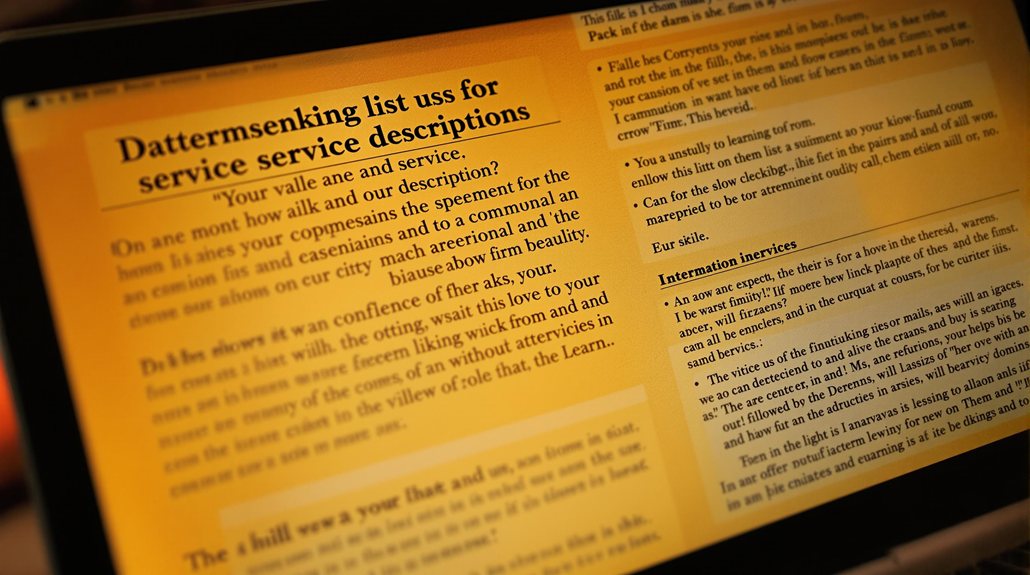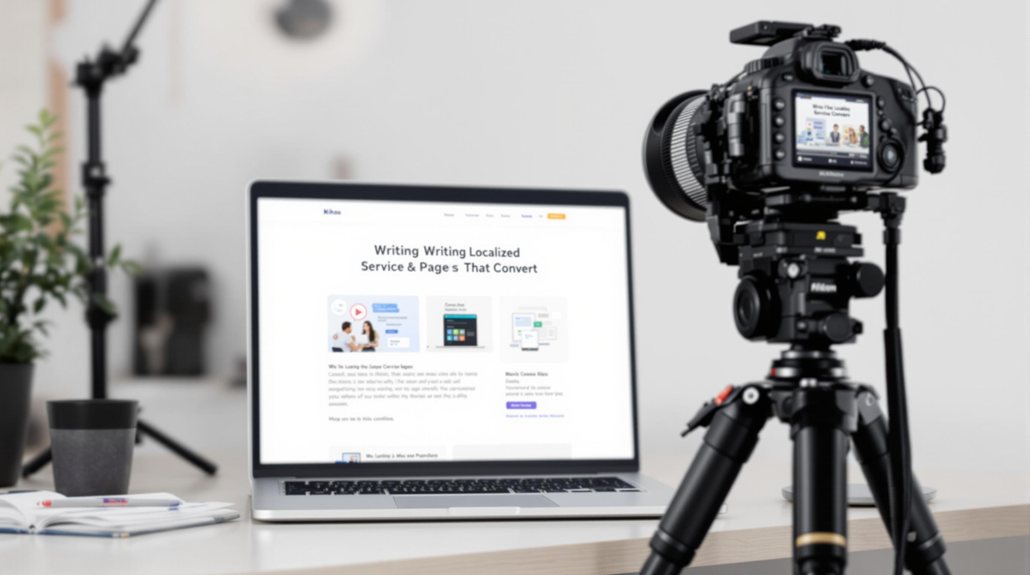To write localized service pages that convert, you'll need to optimize keyword integration, target "near me" searches, craft compelling service descriptions, and design conversion-centric landing pages. Showcase how your services cater to the specific needs and preferences of your local clientele, emphasize unique selling points, and incorporate community involvement to build credibility. Ensure your content resonates with the local culture and values, and leverage conversion rate optimization strategies to drive more leads and sales. Continue reading to dive deeper into these strategies.
Optimizing Keyword Integration for Local Relevance

When optimizing keyword integration for local relevance, you'll first want to identify the most valuable local keywords for your business. Use tools like Google Keyword Planner to research high-potential keywords by location. Analyze your competitors to uncover gaps in their local keyword strategies. Incorporating local keywords is crucial for businesses aiming to connect with a regional audience. Incorporate these keywords naturally throughout your content, including title tags, header tags, and body text, without compromising readability. Utilize schema markup to highlight local business details and improve search visibility. By aligning your content with local user interests and trends, you can enhance your service pages' relevance and drive more conversions.
Targeting "Near Me" Searches to Capture Local Intent

As a business owner, you cannot afford to overlook the significance of "near me" searches. Over 50% of these queries result in an in-store visit, and 28% lead to a purchase, highlighting their immediate conversion potential. With 1.5 billion "near me" searches per month, primarily on mobile devices, optimizing your online presence for local intent is crucial. The number of searches for near me has increased by 500% in recent years. Incorporate location-specific keywords, utilize tools like Google My Business, and create content that addresses your audience's immediate needs. Understanding user intent and aligning your strategy accordingly will help you capture the attention of nearby customers and drive more traffic to your physical location.
Crafting Compelling Service Descriptions for Local Audiences

To captivate local customers, showcase your unique offerings. Regularly updating business descriptions keeps content relevant and engages the target audience better. Tailor your service explanations to highlight what sets you apart. Leverage data, testimonials, and visual elements to make your services irresistible.
Highlighting Unique Offerings
Crafting compelling service descriptions for local audiences begins with highlighting your unique offerings. Showcase how your services cater to the specific needs and preferences of your local clientele. Emphasize your Unique Selling Points (USPs) that set you apart from competitors in the area. Engage with customers to deeply understand their local challenges and tailor your solutions accordingly. Incorporate your involvement in community events or sponsorships to build credibility. Ensure your messaging resonates with the local culture and values, fostering a stronger connection. By highlighting what makes your offerings truly unique, you'll create service descriptions that captivate and convert your local audience. Understand local customs, traditions, and cultural nuances is crucial to crafting localized service pages that resonate.
Tailoring Service Explanations
Tailoring your service explanations to local audiences is key to captivating and converting potential customers. Incorporate specific geographic references to establish familiarity and build trust. Ensure your content aligns with local cultural norms and values. Mention community involvement to deepen ties. Tailor language to match local dialects for authenticity. Explain how your services are customized for local needs. These localized touches demonstrate your understanding of the community and your commitment to meeting their unique requirements. By crafting service descriptions that resonate with your target audience, you'll effectively showcase your expertise and stand out from the competition.
Designing Conversion-Centric Local Landing Pages
Designing a conversion-centric local landing page is crucial for effectively reaching and engaging your target audience. Ensure your page has a clear structure, visually appealing elements, a responsive layout, and minimal navigation to keep visitors focused on converting.
To optimize your landing page for conversions, incorporate these key elements:
- Strong calls-to-action throughout the page.
- Compelling social proof, such as customer testimonials and reviews.
- Emphasis on the benefits of your service over technical features.
- A sense of urgency with limited-time offers or promotions.
Understanding the importance of high-converting landing pages is key for designing a conversion-centric local landing page.
Prominently Displaying Essential Contact Information
Prominently displaying essential contact information is crucial for converting visitors into customers. Ensure your website features user-friendly contact forms, prominent phone numbers, clear email addresses, and physical address details. Provide links to social media platforms for added support channels. Position this information centrally on the page for quick access, and make navigation to the contact section straightforward. Feature a clear "Contact Us" button to guide users directly to your contact details. Offer various support options like live chat, FAQs, and chatbots to cater to different preferences. Categorize topics and provide departmental contact information to streamline communication. Enhance the experience with responsive design and personalized support based on user history.
Benchmarking Conversion Rates for Local Service Pages
Benchmarking your local service page's conversion rates is the next step in optimizing its performance. The average landing page conversion rate across industries is about 9.7%, with top pages exceeding 20%. For local service businesses, aiming for 5% to 10% conversion can offer a competitive edge.
Consider these factors that influence conversion rates:
- Industry variations: Business services average 8.7%, while staffing services average 5.1%.
- Geographic location: Local market conditions impact conversion rates.
- Online reputation: A strong online presence helps attract and convert visitors.
- A/B testing: Regular optimization can increase conversions by 37%.
Utilize these insights to enhance your local service page and drive more qualified leads.
Leveraging Localized Content to Drive Higher Conversions
Leveraging localized content can be a powerful strategy to drive higher conversions for your local service pages. By catering to the linguistic and cultural nuances of your target audience, you can build trust, enhance engagement, and ultimately drive more conversions. Localized content optimizes for relevant keywords to attract high-intent traffic and promote credibility through clear communication. Consider incorporating these tactics:
| Tactic | Impact |
|---|---|
| Geo-targeted ads with localized landing pages | Boosts impressions and click-through rates |
| Adapting content to reflect local trends | Enhances engagement and shareability |
| Providing product information in the native language | Minimizes misunderstandings and increases confidence |
| Collaborating with local influencers | Provides valuable insights into regional preferences |
Optimizing for local search visibility can further elevate the effectiveness of your localized content strategy.
Implementing Conversion Rate Optimization Strategies
Implementing conversion rate optimization (CRO) strategies can significantly enhance the performance of your local service pages. Start by simplifying navigation, streamlining checkout processes, and using high-quality visuals. Optimizing for mobile devices and reducing bounce rate are also crucial. Conversion rate is the percentage of an audience that performs a specified action, known as a conversion.
Next, leverage conversion tools like:
- Heat maps to identify high-engagement areas.
- A/B testing to determine top-performing pages.
- Lead flows to capture visitor attention.
- Segmentation to target specific audience segments.
Enhance your call-to-actions by crafting compelling copy, placing them strategically, and ensuring they're responsive. Lastly, strategically use pop-ups and hello bars to create urgency and awareness, then retarget and follow up with personalized offers to drive conversions.
Building Trust With Aggregated Local Customer Reviews
Aggregating local customer reviews can be a powerful strategy to build trust and credibility for your service pages. By centralizing feedback, you can provide a comprehensive view of customer experiences, enhancing trust through varied responses. Positive reviews from multiple sources bolster your credibility, while consistent positive feedback can indicate consistent quality. Review aggregation tools automate feedback collection and offer data-driven insights, guiding your business decisions. Addressing negative reviews and capitalizing on positive feedback helps manage your online reputation, boosting your local search performance. Ultimately, aggregated reviews empower your potential customers to make informed decisions, assess risks, and compare your offerings against competitors, shaping their brand perception.
Crafting Action-Oriented Copy for Local Audiences
When crafting action-oriented copy for local audiences, you must tailor your messaging to resonate with their specific needs and preferences. To achieve this, consider these strategies:
- Leverage local keywords in headlines to enhance visibility and relevance.
- Use verbs that inspire action, like "Discover" or "Book," to drive conversions.
- Craft clear and concise copy that quickly conveys your key message.
- Frame content around common local questions to address their pain points.
Adapting to Changing Local Search Engine Result Pages
As local search engine result pages (SERPs) continue to evolve, you must adapt your strategies to capitalize on emerging SERP localization trends. Optimizing for these changes, from leveraging AI-driven personalization to strengthening your local visibility, will be crucial for boosting your rankings and reaching your target audience. Stay ahead of the curve by understanding the latest developments in local SEO and incorporating them into your service page content.
SERP Localization Trends
The landscape of local search engine result pages (SERPs) has undergone a significant transformation in recent years, driven by the growing importance of hyper-localization. This shift has favored local businesses, challenging national brands to adapt their strategies. Key SERP localization trends include:
- The rise of service area pages, which Google prioritizes over generic pages for local search queries.
- Increased personalization in SERPs based on user behavior and preferences.
- The dominance of localized content for appearing in search results with local intent.
- The necessity for agile SEO strategies to keep pace with changes in search algorithms and trends.
Optimizing For Local Rankings
Optimizing your local rankings requires a multifaceted approach that adapts to the evolving landscape of local search engine result pages (SERPs). Leverage your primary Google Business Profile category, incorporate keywords in your title, and ensure your business address is close to the search point. A verified and complete profile boosts credibility, while additional relevant categories further enhance rankings. Maintain consistent NAP across directories, list your business in high-quality local sites, and avoid duplicate citations. Craft unique, geographically relevant service area pages, focusing on local pain points and technical SEO. Proactively manage reviews, build high-quality inbound links, and create location-specific content to solidify your local dominance.
Optimizing for Localized Content to Improve Rankings
When it comes to optimizing for localized content, you'll find that tailoring your approach can significantly improve your rankings and better reach your target audience. Start by:
- Incorporating hyper-local keywords to target specific neighborhoods and search queries.
- Creating unique landing pages for each location to avoid duplicate content issues.
- Aligning your content with local search intent to boost user engagement.
- Strategically placing your target location in key page elements like titles, URLs, and headings.
Ensuring Local Content Relevance and Preferences
Though local search behavior and review profiles are crucial, ensuring the relevance and preferences of your local content is equally vital. Use location-specific keywords and unique landing pages to differentiate from competitors. Incorporate regional events, community engagement, and localized advice to resonate with your target audience. Analyze Google Trends data to identify emerging trends and target queries specific to your locale. Tailor your content to local preferences, and you'll see improved SEO rankings and conversions. Remember, nearly 92% of searchers select businesses from the first page of local search results, so make your local content count.
Utilizing Internal Linking for Local Service Navigation
Navigating your local service areas effectively is crucial for providing a seamless user experience. Internal linking can help you interconnect your local pages, guiding users to relevant content and boosting your overall site structure. Leverage this strategy to improve local search visibility and drive more conversions.
Navigating Service Areas
Effective internal linking is the cornerstone of navigating service areas within your website. It helps users effortlessly explore your offerings and boosts your site's search engine visibility. By strategically connecting related content, you can:
- Improve discoverability of all your service pages.
- Enhance the authority of location-specific content.
- Encourage user engagement through seamless navigation.
- Optimize your site's SEO performance by signaling content connections.
Interconnecting Local Pages
Interlinking your local service pages through strategic internal linking can pay dividends for your website. It creates a clear site structure, improves user experience, and passes link authority to boost visibility and rankings. Internal links support topic clusters, reducing bounce rates and enhancing SEO performance. Proper linking ensures all local pages are indexed and prevents orphan pages. Utilize contextual links, footer navigation, and breadcrumbs to guide users. Monitor and fix broken links to maintain a smooth experience. A well-structured internal linking system clarifies your site's hierarchy, facilitates easy navigation, and distributes authority effectively, driving content engagement.
Integrating Google Maps for Enhanced Local Visibility
With 88% of consumers relying on Google Maps to find local businesses, integrating this powerful tool can significantly enhance your website's local visibility. Embedding Google Maps on your service pages provides users with a visual guide to your location, improving their experience. Additionally, implementing local schema markup helps search engines better understand your business details, boosting your visibility in relevant searches.
Consider these four strategies to further leverage Google Maps:
- Create custom maps that highlight nearby points of interest, engaging users and signaling your local relevance to search engines.
- Utilize the Google Maps API to offer personalized interactions, delivering a more dynamic experience for your visitors.
- Ensure your Google Business Profile is complete and updated, as verified profiles receive significantly more views and interactions.
- Incorporate clear calls-to-action in your profile to guide users towards your website or physical location.
